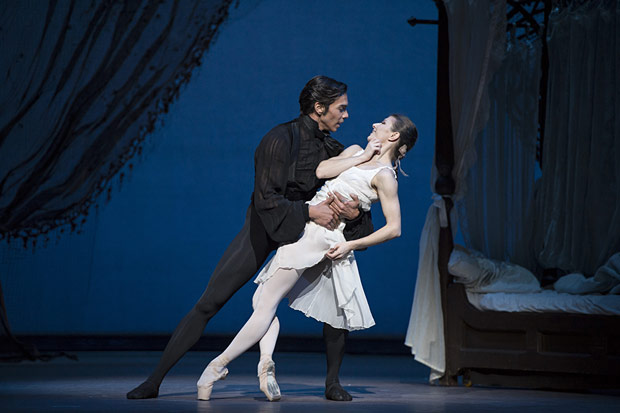
© Bill Cooper, by kind permission of the Royal Opera House. (Click image for larger version)
The Royal Ballet
Onegin
London, Royal Opera House
19 January 2013
Gallery of 36 pictures by Dave Morgan – Soares/Nunez cast
www.roh.org.uk
www.stuttgart-ballet.de
Cranko called his 1965 ballet Onegin, after Pushkin’s poem and Tchaikovsky’s opera, Eugene Onegin, though the central character is the heroine, Tatiana. We suffer for her at the end of the ballet, while Onegin is the one who will be lonely, rootless and heartbroken (serve him right). She has her husband and social status – and children – to console her.
Since the Royal Ballet brought in a new Onegin at short notice for the opening night of the run, it’s worth wondering, yet again, who Cranko’s Onegin is. Jason Reilly came from the Stuttgart Ballet to replace injured Johan Kobborg as Alina Cojocaru’s partner. He’s a tall Canadian who joined the Stuttgart company in 1997, was promoted to principal dancer in 2003 and was persuaded to remain in Germany by the prospect of guesting elsewhere in Europe. (He has performed before with the Royal Ballet, in Tetley’s Voluntaries.)

© Bill Cooper, by kind permission of the Royal Opera House. (Click image for larger version)
We see Onegin almost entirely through Tatiana’s eyes. His only opportunity to account for himself is his brooding solo in Act I: tricky turns, lunges and changes of direction, hand to brow. He has Tatiana as a wide-eyed witness, so he might be showing off rather than simply musing to himself. Reilly keeps him reserved and enigmatic, impressing her with his world weariness: what could be more intriguing to a romantic adolescent? He doesn’t deign to notice her tentative outstretched hand, though he knows it was there.
Young Tatiana is vulnerably naïve, her bourrées fluttering with excitement. Cojocaru has taken to wearing too much eye makeup for a country girl; Olga is meant to be the pretty sister, Tatiana the bookish one who doesn’t care about her appearance. But Cojocaru’s small stature means she can look child-like, a great advantage in the mirror pas de deux that ends Act I.
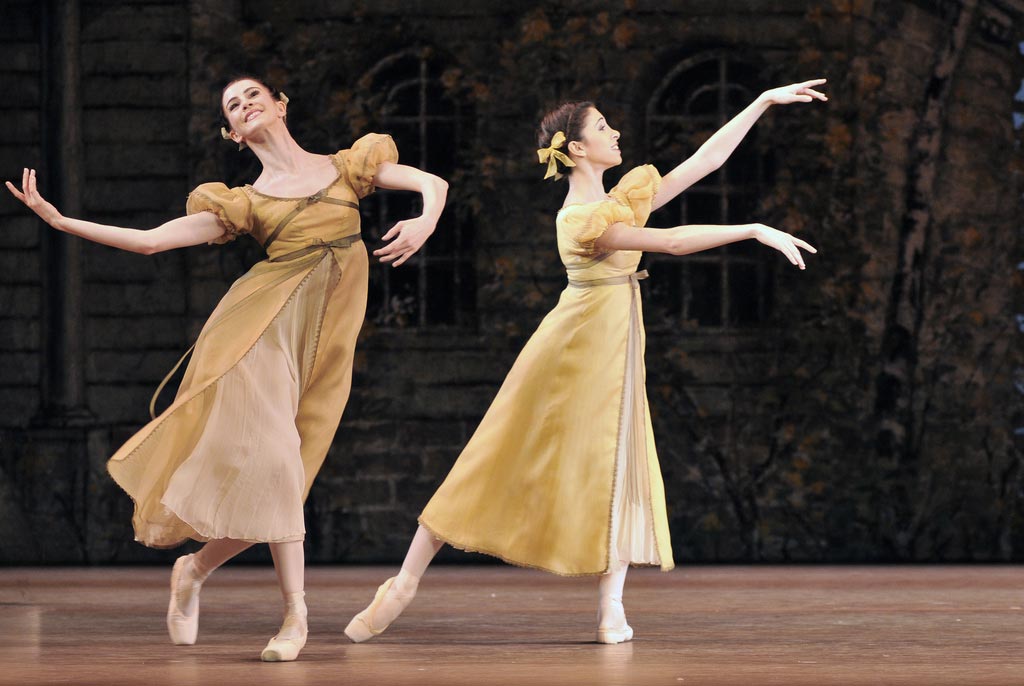
© Dave Morgan, by kind permission of the Royal Opera House. (Click image for larger version)
Shadowy Onegin is her fantasy, the ideal lover to whom she addresses her infatuated letter. Reilly, dark-featured as well as dressed all in black, is almost invisible. Cojocaru, in a white nightdress, flies from his arms like a moth around a flame, swirling giddily about him. Thanks to Reilly’s height and strength, she is literally swept off her feet – almost frighteningly so in an unfamiliar partnership, though appropriate for Tatiana’s dream of erotic passion.
There’s an unintended contrast with the pairing of Akane Takada and Steven McRae as Olga and Lensky. Light though she is, she’s too much of an armful for him: the lifts in their Act I pas de deux are a struggle. Takada’s Olga is sincerely in love with her fiancé, with no hint of naughtiness. She’s just lovely, as are her pirouttes and bouncy jumps. McRae’s Lensky I found hard to read. He seems too conscious of how well he dances, though that might be Lensky being pleased with himself, before he remembers to address the finish of his immaculate turns and arabesques to Olga. His self-important character is going to be as much to blame as Onegin for their duel in Act II.
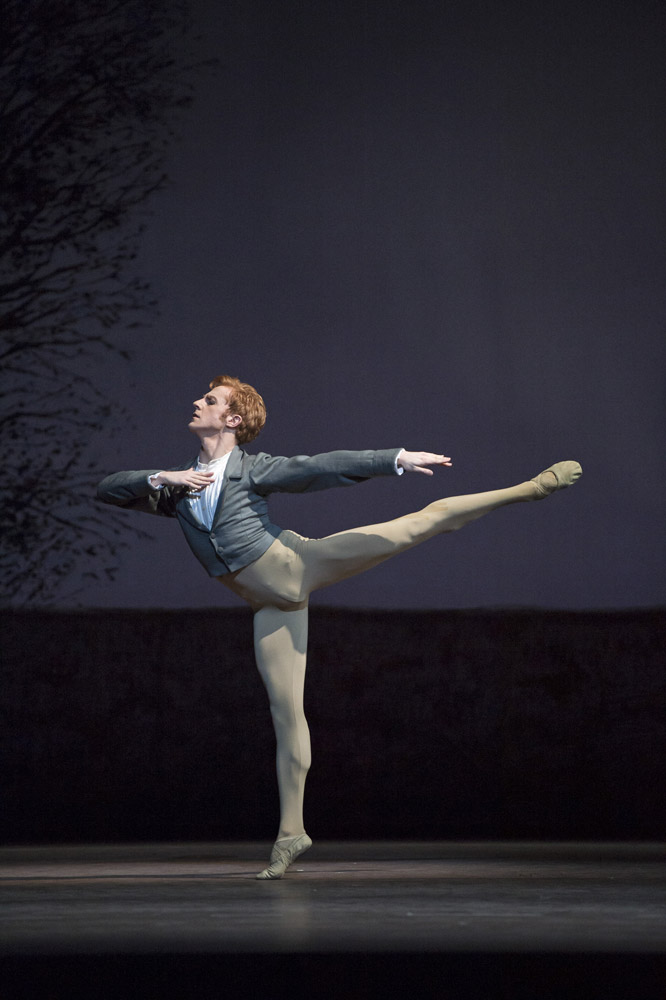
© Bill Cooper, by kind permission of the Royal Opera House. (Click image for larger version)
In Pushkin’s poem, Onegin has cause for being annoyed with Lensky for misleading him about the celebration of Tatiana’s name-day (the first scene of Act II in the ballet). He thought it was to be an intimate gathering, not a tedious provincial knees-up. He avenges himself by dancing possessively with Olga, until Lensky over-reacts in jealousy. McRae presents him as a bantam cockerel challenging a rival. In the ballet, however, Onegin’s target seems to be Tatiana rather than Lensky. He humiliates her by tearing up her letter and placing it in her trembling hands, then pointedly preferring her sister. So we’re still seeing his cruelty through Tatiana’s eyes: he’s the imagined lover who has spurned her in front of her family and friends. Cojocaru, very touching, dances the wounded girl’s solo as though each phrase is a spontaneous, unguarded response to her distress.
McRae performs his pre-duel solo with great deliberation, making every step, every shape, perfect. This is a ballet-poet’s ideal farewell to the world, not a scared young man dreading his fate. Cranko’s choreography in the duel scene mixes genres of movement: the two sisters’ lament is expressionistic, the perfunctory duel symbolic; Onegin is merely a cypher until he breaks down realistically. The scene is a nightmare counter to the naturalistic conventions of the party that set the unnecessary death in train.

© Dave Morgan, by kind permission of the Royal Opera House. (Click image for larger version)
Act III veers between balletic set-pieces and melodrama, with a rare marital pas de deux at the start. Cojocaru’s mature Tatiana seems more than content in her marriage with Bennet Gartside’s Prince Gremin, who clearly adores her. Their duet in this interpretation is a tender, very personal one in the midst of a formal society ball. Reilly’s saturnine Onegin lurks on the fringes, tortured by regret. His motives for writing an imploring letter to Tatiana are unclear: Reilly doesn’t imply that he’s psychologically damaged, as Kobborg does (or did).
Cojocaru is as great a dance-actress in the final scene as any I’ve been privileged to see – and that includes Lynn Seymour, Natalia Makarova and Ekaterina Maximova. Because Reilly’s Onegin remains an enigma, Cojocaru reveals that Tatiana’s turbulence is all about her, not him; her emotions are a resurgence of her younger self. She wants to believe in the truth of her infatuation with the Onegin she imagined as a lovestruck girl: indeed, the swirling lifts in the last pas de deux are a reminder of the ‘mirror’ duet, which was, of course, only a dream. Yet here he is, prostrate at her feet, vowing he always loved her – another fantasy. She could be tempted, like Anna Karenina, to abandon her husband and social position and run away with him.
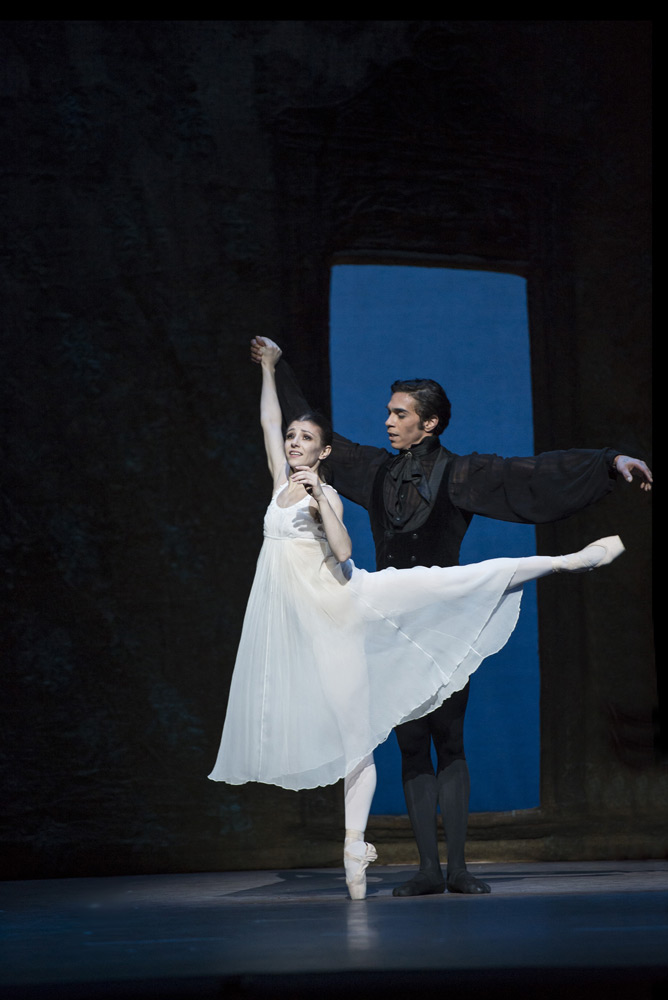
© Bill Cooper, by kind permission of the Royal Opera House. (Click image for larger version)
Why doesn’t she give in? Seymour and Maximova nearly did, until the very last moment. Makarova steeled herself to avenge the girl she once was, tearing up his letter to hurt him in return (while hurting herself). Cojocaru, as she soars through the air in Onegin’s arms once again, realises she’s being manipulated. She takes charge of her life and overrules him. She pays the cost, but not to the degree she experienced when she rejected Kobborg’s Onegin in the past. The shift in her interpretation is that of a mature artist understanding her role in a new light. And Cojocaru’s technical ability is so assured that you’re caught up in the character’s thoughts and feelings rather than marvelling at the beauty of her dancing.














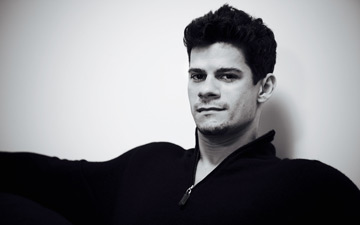
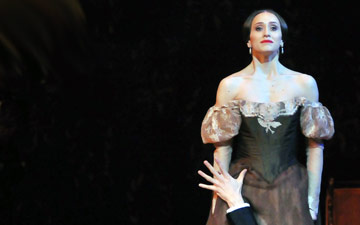
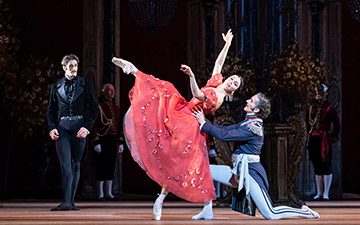
Onegin has never looked totally at home at Covent Garden – but with Valeri Hristov, Sarah Lamb, Dawid Trzensimiech and Yasmine Naghdi as the protagonists we had a quartet that understood the dynamics of their characters. The peasant dances were crisper and the Larin party less guyed – both for the better. The ballet was altogether more subtle.
Naghdi was a suitably foolish Olga, Trzensimiech a callow Lensky – well acted but his dancing was staccato. The torrent of steps before the duel remained that, rather than a flood of emotion. As Gremin, Thomas Whitehead was every mother’s ideal son-in-law – though Whitehead’s sparky stage presence made him too vivid a presence to explain Tatiana’s claustrophobia in their marriage.
Hristov was made-up to resemble Stewart Granger in Footsteps in the Fog – but there was not a whiff of melodrama about his performance. Every action, every movement was patrician, where honour is all – as the drop cloth legend reminds us. Rather than the histrionics to which many Onegins succumb as they are banished, Hristov made us as much concerned for this Onegin as for Tatiana.
Lamb was an intelligently nuanced Tatiana, particularly impressive in her icy stare that withers Onegin after the duel. She was dutiful and impassive when paraded around the ballroom, Gremin’s trophy wife. How passionless that pas de deux is compared to the others in the ballet. “Nice,” somebody in front of me whispered. Nice does not a marriage make. Amid the drab brown sitting room, the conflict of duty and instinct was razor sharp in the last scene. When Hristov abased himself for the second time at Lamb’s feet she looked as though she wanted to be violently sick.
My criticism of both Hristov and Lamb as performers is that they are not expansive performers. I wanted there performances to be bigger, to project more. But their miniaturist subtleties gave greater depth to the ballet.
Onegin is still a better ballet than The Royal Ballet makes it look. Cranko’s choreography needs to danced with more danger, by a more obviously theatrical company. Performances by English National Ballet remain rooted in the memory. Now that’s a company who have some marvellous Tatianas amid their ranks.